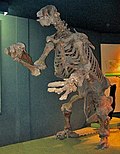Ground sloth
Ground sloths are a group of extinct large sloths in the mammalian superorder Xenarthra. The much smaller living sloths are called "tree sloths".
| Ground sloths | |
|---|---|

| |
| AMNH mounts of (from left) Megalocnus rodens, Scelidotherium cuvieri, Megalonyx wheatleyi, Glossotherium robustus | |
| Scientific classification | |
| Kingdom: | |
| Phylum: | |
| Class: | |
| Superorder: | |
| Order: | |
| Suborder: | Folivora (partim)
|
| Families | |
| |
The last surviving ground sloths lived in the Caribbean Antilles. Megalocnus may have survived until about the third century BC in Cuba.[1] By then ground sloths had been extinct on the mainland of North and South America for 10,000 years or more.[2] They survived on Caribbean islands because humans got to the islands much later. Some island sloth populations lived 5,000-6,000 years later than their continental mainland relatives. This fits the pattern of Holocene extinction of large vertebrates due to human dispersal. In other words, they were probably hunted or otherwise so affected by humans that they were unable to survive.[3]
Most ground sloth evolution took place during the mid to late Tertiary of South America while the continent was isolated.[4] At their earliest appearance in the fossil record, the ground sloths were already quite distinct. The presence of islands between the American continents in the Miocene allowed some to get into North America.
Ground sloths were a hardy group: their numbers and dispersals into remote areas are evidence of this. Remains have been found in parts of Alaska.[5][6]
Sloths, and xenarthrans as a whole, were one of the more successful South American groups during the Great American Biotic Interchange. In general, during the interchange, many more taxa moved from North America into South America than in the other direction. However,at least five genera of ground sloths have been identified in North American fossils. These are examples of successful migration to the north.
Typical examples
Ground Sloth Media
Fossil Eremotherium skeleton, National Museum of Natural History, Washington, DC.
A Tamandua anteater in an upright defensive stance similar to those presumed to have been adopted by ground sloths, per trackways preserved in New Mexico
Subfossilized Nothrotheriops shastensis dung in Rampart Cave, Arizona (NPS, 1938)
References
- ↑ MacPhee R.D.E; Iturralde-Vinent M.A.; Vázquez O.J (2007). "Prehistoric sloth extinctions in Cuba: implications of a new "last" appearance date" (PDF). Caribbean Journal of Science. 43 (1): 94–98. doi:10.18475/cjos.v43i1.a9. S2CID 56003217. Archived from the original (PDF) on 20 July 2011. Retrieved 11 May 2009.
- ↑ Fiedal, Stuart (2009). "Sudden deaths: the chronology of terminal Pleistocene megafaunal extinction". In Haynes, Gary (ed.). American Megafaunal Extinctions at the End of the Pleistocene. Vertebrate Paleobiology and Paleoanthropology. Springer. pp. 21–37. doi:10.1007/978-1-4020-8793-6_2. ISBN 978-1-4020-8792-9. Archived from the original on 2012-12-05. Retrieved 2014-04-28.
- ↑ Steadman D.W.; et al. (2005). "Asynchronous extinction of late Quaternary sloths on continents and islands". Proceedings of the National Academy of Sciences USA. 102 (33): 11763–11768. Bibcode:2005PNAS..10211763S. doi:10.1073/pnas.0502777102. PMC 1187974. PMID 16085711.
- ↑ Hogan C.M. 2008. Cueva del Milodon, Megalithic Portal.
- ↑ Stock, C. (29 May 1942). "A ground sloth in Alaska". Science. American Association for the Advancement of Science. 95 (2474): 552–553. Bibcode:1942Sci....95..552S. doi:10.1126/science.95.2474.552. PMID 17790868.
- ↑ McDonald, H.G.; Harington C.R.; De Iuliis G. (September 2000). "The ground sloth Megalonyx from Pleistocene deposits of the Old Crow Basin, Yukon, Canada" (PDF). Arctic. Calgary, Alberta: The Arctic Institute of North America. 53 (3): 213–220. doi:10.14430/arctic852. Archived from the original (PDF) on 3 July 2020. Retrieved 16 August 2008.



